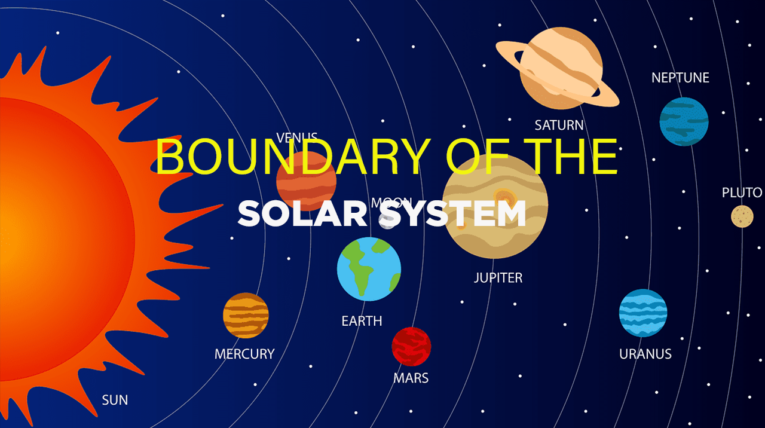Let us first greet all you fellow cosmic enthusiasts; Happy Litha! Wondering what it means? It means that the Summer Solstice is arriving! So get ready with a scoop of your favorite ice cream because in this scorching heat of June you are going to witness the longest day of the year, the June Solstice or simply the Summer Solstice! Interesting, right? So let’s dive into the fascinating celestial mechanics that results in this phenomenon!
What exactly is the Summer Solstice?
The longest day of the year, the “Summer Solstice” falls every year between 20th and 21st June, depending on your timezone. This is the time when our Sun is at its highest maximum position in the sky directly above the Tropic of Cancer, that is at 23.5°N latitude.
But, how exactly does this happen? For this, you first need to know the celestial mechanics between the Sun and Earth!
Motion of Earth around the Sun:
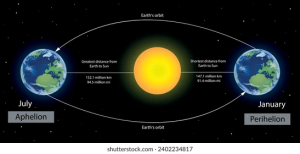
We know that all the planets in our solar system follow an elliptical orbit, but here’s the catch: is the orbit of earth really elliptical?
You may have heard about these terms, aphelion and perihelion. Perihelion marks the position when the earth is closest to the sun, that is around 91,500,000 miles away from the Sun. And what about aphelion? You guessed it right, it is when the Earth is at the farthest position from the sun, which is nearly 94,500,000 miles. If you look at those numbers, this accounts for a difference of relatively 3 million miles, which seems like an awful lot but is really not that much in astronomical scales, so we can safely say that the earth traces a nearly circular orbit, completing a full revolution in about 365.25 days.
Here, you must have pondered if there is mere difference in these positions, then how do we experience such drastic variation in seasons? Got Curious? Let’s find out!
The Importance of Earth’s Axial tilt:
Our Earth, if you imagine, is like a giant spinning top. Not exactly upright but tilted. The axial tilt is nearly 23.5 deg, relative to its orbital plane. This tilt is the key secret behind the changing seasons! This tilt remains constant throughout the year. So different parts or areas of the globe receive different amounts of incident sunlight during its orbital period, leading to seasonal variations. This is also the reason behind differential sunrise and sunset times experienced throughout the year!
This is where the equinox and solstices come into the picture. This is where things become interesting!
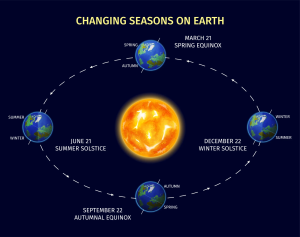
Solstices and Equinoxes: Crucial Points in the Earth’s Orbit:
Let’s break these terms in a simple manner, Our earth is divided into the southern hemisphere and the northern hemisphere. Solstices occur twice a year when the Sun’s course reaches its northern or southernmost positions relative to the equator, whereas Equinoxes happen when the Earth’s tilt causes the Sun to lie directly above the equator , producing approximately equal day and night durations all around the world twice a year. It is the axial tilt of the earth that drives these seasonal changes in each hemisphere.
Let’s look into each of these occurrences, starting with the Star of June, the Summer Solstice!
Summer Solstice (June 20/21):
During summer solstice, the Northern Hemisphere is tilted towards the Sun at its maximum extent, illuminating the region on and around the Tropic of Cancer. Consequently, the Sun’s rays hit the Northern Hemisphere more directly, resulting in longer days and higher temperatures. Meanwhile, the Southern Hemisphere experiences winter because it is tilted away from the Sun.
Autumnal Equinox (September 22/23):
Just after the Summer Solstice, we arrive at the Autumnal Equinox; “equinox” generally means, equal day and equal nights. Autumn officially begins on or around September 23rd, which is also known as the autumnal equinox. During an equinox, the Sun is directly overhead the equator and everywhere on Earth experiences around 12 hours of sunshine and 12 hours of darkness. This occurs as the Sun moves southwards towards the equator from the Tropic of Cancer.
Winter Solstice (December 21/22):
After the summer solstice, the Sun’s path starts to move southward even further, from the equator to the Tropic of Capricorn. During the Winter Solstice, which occurs on or around December 21st, the Northern Hemisphere is tilted away from the sun leading to shorter days and lesser temperatures and this region experiences winter. Consequently the Southern Hemisphere is tilted towards the sun, and receives maximum sunlight. The sun rays are incident more directly, and this region experiences summer.
Vernal / Spring Equinox (March 20):
Right after winter, the sun gradually starts moving northwards again, to repeat the entire process. This is where it reaches the equator the second time of the seasonal year. Therefore, similar to the Autumnal equinox, the sun shines bright over the equator on March 20, where we experience the Vernal equinox, or simply known as Spring equinox. The tilt of the Earth’s axis is such that neither the Northern Hemisphere nor the Southern Hemisphere is tilted towards or away from the Sun, marking the period of equal day and night!
If you want to know more about the Summer solstice, Winter solstice and equinoxes then click here.
Does the Sun Always Rise in the East and Sets towards the West?
The idea that the Sun always rises in the east and sets in the west is among the most widespread ones. While this is generally true, If you go out with your camera and click pictures of the sun everyday from the same location and at the same time over a year, you will observe an eight-like pattern, this pattern is known as an analemma.
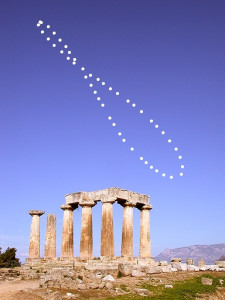
Credits: Photographs by Anthony Ayiomamitis
Looks fascinating, right? Now this means, the rising point and setting point of the sun changes daily, and this is due to the axial tilt of the earth. Let’s have a look at the intriguing dynamics of the Sun’s motion throughout the year and how it influences our observations.
Summer Solstice: Northernmost Sunrise and Sunset
During the summer solstice, around June 21st , the Sun’s rising and setting points are at their most extreme. If you wish to see the sunrise and sunset at higher altitudes from the Northern hemisphere, you would see that the Sun deviates from the precise east-west alignment, rising slightly northeast and setting slightly northwest.
Winter Solstice: Southernmost Sunrise and Sunset
In contrast to summer solstice, during the Winter Solstice the sun rises and sets at its southernmost points on the horizon. This results in shorter days and longer nights. During this time, the Sun appears to rise in the southeast and set southwest.
Equinoxes: East and West at perfect angles
The Sun rises precisely in the east and sets precisely in the west only during the equinoxes in contrast to Summer solstice and winter solstice. This happens because day and night durations are identical due to the Earth’s axis tilt, which is perpendicular to the Sun’s beams.
If you really want to explore an interactive visualization of the shift in the position of the Sun’s motion precisely “analemma” then, click here.
You just need to enter the latitude and longitude of your place, set the time zone accordingly , set a particular time and just vary the dates over a course of one year. Now you are all set to track the motion of the sun. Isn’t it interesting?
The Journey of the Sun: From Uttarayan to Dakshinayan.
We all are always skeptical, to understand whether Science and culture go hand in hand. But this is not the case here, to understand the journey of our sun through June or Summer solstice we need to dig deeper into vedic culture.
According to Vedic Astronomy, there are two different phases that represent the journey of the Sun across the sky, the Uttarayan and Dakshinayan.
The Northward trek:
During Uttarayan, the Sun travels from the sign of Capricorn to the sign of Gemini. This six-month period normally begins in January around the time of Makar Sankranti, the harvest festival. Literally meaning, Uttarayan is the time of day when the Sun starts its northward trek. This occurs in conjunction with the summer solstice, which occurs in the Northern Hemisphere on June 21st, typically, marking the longest day and the shortest night. During Uttarayan, the North Pole tilts towards the Sun, leading to increased daylight hours in the northern hemisphere.
The Southward trek:
Dakshinayan will start on June 21 or 22 i.e, on Summer Solstice. On June 21, the sun moves from Uttarayan to Dakshinayan. The Sun moves with an inclination towards the south, from the sign of Cancer into the signs of Leo, Virgo, Libra, Scorpio, and Sagittarius. During this Dakshinayan period daylight is shorter and the temperatures are cooler in the northern hemisphere. The Sun’s southward trek continues until the winter solstice that is till 21st December.
The First Point of Aries:
Imagine a giant sphere around the Earth, called the Celestial Sphere. Now if you project the earth’s celestial equator over this sphere, this will be called the Celestial Equator which divides the northern and southern celestial hemispheres. If you observe the Sun’s apparent motion across the sky throughout the year, it will follow a path called the ecliptic.
Wondering why this was important?Because, the First Point of Aries is the point where the ecliptic intersects the celestial equator. Yes you heard it right! It signifies the start of spring or vernal equinox in the Northern Hemisphere and fall or autumnal equinox in the Southern Hemisphere.
But here’s the catch! The celestial equator progressively shifts over thousands of years as a result of the Earth’s modest axial wobbling, a process known as precession. This causes the First Point of Aries to precess into Pisces rather than still lying in the constellation of Aries.
So why does the summer solstice still hold significance for the First Point of Aries, even with its present location? This location did, in fact, correlate with the constellation Aries when it was initially determined by astronomers in antiquity. In order to map the locations of stars and planets, celestial coordinate systems still begin with this historical reference point. In addition, on the summer solstice (for the Northern Hemisphere), when the Sun is at its northernmost point in the sky, the length of the day reaches its zenith. From there, the days get progressively shorter, taking us towards the autumnal equinox and, at the completion of the celestial cycle, towards the First Point of Aries.
Prominent Constellations around Summer Solstice:
Summer Solstice promises stargazers to have a look at some of the most prominently visible constellations and especially the well-known asterism called the Summer Triangle in the night sky.
The Astonishing Summer Triangle:
The Summer Triangle is a large asterism consisting of three bright stars: Vega in Lyra, Altair in Aquila, and Deneb in Cygnus. During summer, it dominates the night sky and serves as a good starting point for locating other constellations.
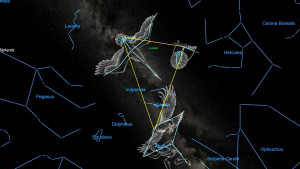
Lyra, the Harp:
Vega, the brightest star in the constellation Lyra, makes it easy to recognise despite its tiny size. One of the stars nearest to Earth, Vega is the fifth brightest star in the night sky and second brightest in the northern hemisphere with a visual magnitude of 0.03. You can easily spot this constellation making a shape of a harp!
Cygnus, the Swan:
Often referred to as the Northern Cross, Cygnus, also known as the Swan, is a big and easily visible constellation because of its unique cross form. Despite being relatively far from Earth, Interestingly, Deneb represents the tail of the swan and represents one of the vertices of the Summer Triangle. You can easily spot deneb just by extending your arm, making a fist and stretching the thumb and pinky finger (corresponds to 25 degrees) and looking down towards left at 24 degrees, from Vega.
Aquila, the Eagle:
If you just move towards the lower right from Vega, nearly at 34 degrees you will spot Altair! The only thing you need to do is extend one of your fists! The constellation of Aquila represents an eagle and Altair forms the third point of this amazing summer triangle!
That’s it! You have connected the dots to see this beautiful summer triangle asterism.
Want to spot these constellations in the night sky? then you should definitely explore the Stellarium app!
But wait! This is not the least you can expect. Apart from the Summer solstice, June is full of astonishing astronomical events you would never want to miss. If you would like to know more about upcoming events in June then you should definitely read about, Amazing Astronomical Events in June-2024
If you want to stay updated on the latest facts and discoveries, then do join our Discord channel! Feel free to ask any queries related to astronomy we’re here to help you explore the wonders of the universe.
Enjoyed reading this? Consider reading
- Summer Triangle : Amazing Secrets of The 3 Celestial Giants
- Gemini: June’s Cosmic Twins and the Enchanting Wonders of the Zodiac
- 7 Mind-Blowing Black holes Discoveries: Redefining the Dark Kings of the Cosmos

